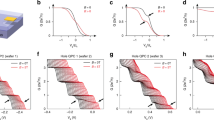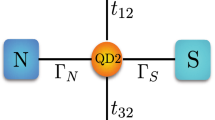Abstract
A quantum point contact (QPC) is a narrow constriction between two wider electron reservoirs, and is the standard building block of sub-micrometre devices such as quantum dots and qubits (the proposed basic elements of quantum computers). The conductance through a QPC changes as a function of its width in integer steps of G0 = 2e2/h (where e is the charge on an electron, and h is Planck's constant), signalling the quantization of its transverse modes1,2. But measurements of these conductance steps also reveal an additional shoulder at a value around 0.7G0 (refs 1–4), an observation that has remained a puzzle for more than a decade. It has recently been suggested5,6 that this phenomenon can be explained by the existence of a magnetic ‘impurity’ in the QPC at low electron densities. Here we present extensive numerical density-functional calculations that reveal the formation of an electronic state with a spin-1/2 magnetic moment in the channel under very general conditions. In addition, we show that such an impurity will also form at large magnetic fields, for a specific value of the field, and sometimes even at the opening of the second transverse mode in the QPC. Beyond explaining the source of the ‘0.7 anomaly’, these results may have far-reaching implications for spin-filling of electronic states in quantum dots and for the dephasing of quantum information stored in semiconductor qubits.
This is a preview of subscription content, access via your institution
Access options
Subscribe to this journal
Receive 51 print issues and online access
$199.00 per year
only $3.90 per issue
Buy this article
- Purchase on Springer Link
- Instant access to full article PDF
Prices may be subject to local taxes which are calculated during checkout




Similar content being viewed by others
References
van Wees, B. J. et al. Quantized conductance of point contacts in a two-dimensional electron gas. Phys. Rev. Lett. 60, 848–850 (1988)
Wharam, D. A. et al. One-dimensional transport and the quantisation of the ballistic resistance. J. Phys. C 21, L209–L214 (1988)
Thomas, K. J. et al. Possible spin polarisation in a one-dimensional electron gas. Phys. Rev. Lett. 77, 135–138 (1996)
Thomas, K. J. et al. Interaction effects in a one-dimensional constriction. Phys. Rev. B 58, 4846–4852 (1998)
Cronenwett, S. M. et al. Low-temperature fate of the 0.7 structure in a point contact: A Kondo-like correlated state in an open system. Phys. Rev. Lett. 88, 226805 (2002)
Meir, Y., Hirose, K. & Wingreen, N. S. Kondo model for the “0.7 anomaly” in transport through a quantum point contact. Phys. Rev. Lett. 89, 196802 (2002)
Graham, A. C. et al. Interaction effects at crossings of spin-polarised one-dimensional subbands. Phys. Rev. Lett. 91, 136404 (2003)
Matveev, K. A. Conductance of a quantum wire in the Wigner-crystal regime. Phys. Rev. Lett. 92, 106801 (2004)
Kristensen, A. et al. Bias and temperature dependence of the 0.7 conductance anomaly in quantum point contacts. Phys. Rev. B 62, 10950–10957 (2000)
Reilly, D. J. Phenomenological model for the 0.7 conductance feature in quantum wires. Phys. Rev. B 72, 033309 (2005)
DiCarlo, L. et al. Shot-noise signatures of 0.7 structure and spin in a quantum point contact. Phys. Rev. Lett. 97, 036810 (2006)
Berggren, K.-F. & Yakimenko, I. I. Effects of exchange and electron correlation on conductance and nanomagnetism in ballistic semiconductor quantum point contacts. Phys. Rev. B 66, 085323 (2002)
Starikov, A. A., Yakimenko, I. I. & Berggren, K.-F. Scenario for the 0.7-conductance anomaly in quantum point contacts. Phys. Rev. B 67, 235319 (2003)
Hirose, K., Meir, Y. & Wingreen, N. S. Local moment formation in quantum point contacts. Phys. Rev. Lett. 90, 026804 (2003)
Kohn, W. & Sham, L. J. Self-consistent equations including exchange and correlation effects. Phys. Rev. 140, A1133–A1138 (1965)
Georges, A. & Meir, Y. Electronic correlations in transport through coupled quantum dots. Phys. Rev. Lett. 82, 3508–3511 (1999)
Aguado, R. & Langreth, D. C. Out-of-equilibrium Kondo effect in double quantum dots. Phys. Rev. Lett. 85, 1946–1949 (2000)
Hohenberg, P. & Kohn, W. Inhomogeneous electron gas. Phys. Rev. 136, B864–B871 (1964)
Jackson, J. D. Classical Electrodynamics 2nd edn 147 (Wiley, New York, 1975)
Tanatar, B. & Ceperley, D. M. Ground state of the two-dimensional electron gas. Phys. Rev. B 39, 5005–5016 (1989)
Acknowledgements
We thank N. Argaman, R. Baer, D. Goldhaber-Gordon, B. I. Halperin, K. Kikoin, W. Kohn and M. Stopa for discussions. This work was supported by the Binational Science Foundation. We also thank the Department of Theoretical Physics at Jožef Stefan Institute for providing access to computer facilities. Author Contributions Y.M. initiated the project. T.R. performed numerical simulations. T.R. and Y.M. analysed results and co-wrote the paper.
Author information
Authors and Affiliations
Corresponding author
Ethics declarations
Competing interests
Reprints and permissions information is available at www.nature.com/reprints. The authors declare no competing financial interests.
Rights and permissions
About this article
Cite this article
Rejec, T., Meir, Y. Magnetic impurity formation in quantum point contacts. Nature 442, 900–903 (2006). https://doi.org/10.1038/nature05054
Received:
Accepted:
Issue Date:
DOI: https://doi.org/10.1038/nature05054
This article is cited by
-
Anomalous conductance quantization of a one-dimensional channel in monolayer WSe2
npj 2D Materials and Applications (2023)
-
Scanning gate imaging of quantum point contacts and the origin of the 0.7 anomaly
Nano Research (2015)
-
Wigner and Kondo physics in quantum point contacts revealed by scanning gate microscopy
Nature Communications (2014)
-
Microscopic origin of the ‘0.7-anomaly’ in quantum point contacts
Nature (2013)
-
Odd and even Kondo effects from emergent localization in quantum point contacts
Nature (2013)
Comments
By submitting a comment you agree to abide by our Terms and Community Guidelines. If you find something abusive or that does not comply with our terms or guidelines please flag it as inappropriate.



